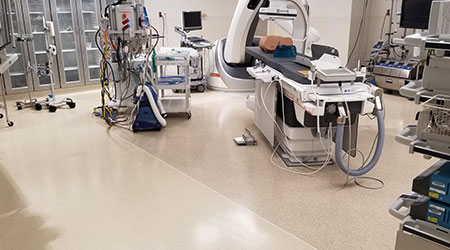Efforts to reduce healthcare-associated infections (HAIs) typically focus on high-touch surfaces. But floors can be an underappreciated source for the dissemination of pathogens, according to research.
While building materials are increasingly becoming important to reduce the transfer risk of infectious diseases, flooring is typically chosen based on its aesthetics, durability and contribution to fall rates. But experts say it’s important to view flooring as part of the chain of infection for low-touch surfaces.
Proactive approach
Paul McKinney, Gerflor USA Inc. Healthcare Segment national sales director, said many stakeholders are taking a proactive approach to design related to flooring and infection control based on this research. Certifications of flooring relative to biological control, isolation and cleanroom design challenges are a growing trend.
“While not a requirement in most healthcare environments, a higher degree of third-party certification is of value to some healthcare providers in the face of enhanced scrutiny in these times of complex, new viruses, while acknowledging that no data exists to differentiate different products performance relative to infection control.”
Flooring design
Kathy Griffel, director of Healthcare for Mannington Mills Inc., said infection control concerns are top of mind in all aspects of healthcare – from acute care hospitals to medical office buildings to senior living. Mannington, she said, crafts floors to not only address the perception of clean, but also the reality of clean. “In the past, healthcare design was often tasked with hiding dirt – designers were asked to choose finishes that camouflaged lack of proper cleaning.
“But in today’s world of infection control awareness, being able to see dirt/spills/stains is vital to providing a truly clean space for patients, families and staff. Good design should not be compromised by bad maintenance.”
Steve Hadrych, Mannington director of Healthcare, said infection control, specifically in acute care settings, is a holistic effort that encompasses specific disinfecting of operating rooms and intensive care units, to voluminous cleaning of non-high touch flooring, including open public spaces, patient care corridors and patient rooms.
“Integrated delivery networks set their specific infection care protocol,” Hadrych said, “The best we can do is afford them a floor that meets their expectations for cleanability.”
Flooring choices
Mark Huxta, Ecore International’s National Healthcare Director, said infection control is not so much a trend as a necessity. He sees providers utilize products that offer enhanced maintainability.
“The key is efficacy with minimal disruption to patients and staff,” Huxta said. “No-wax floors have been the go-to products of choice for a number of years, effectively eliminating the strip-wax-buff regimen.”
In most healthcare spaces, hard surface flooring is the go-to flooring due to its durability and cost effectiveness. Hard flooring is most often replaced to change the aesthetics of a space. And if maintained properly, a hard surface floor could last 20 years, according to Lewis G. Migliore, president of Georgia-based LGM and Associates.
Migliore said healthcare facilities typically use sheet vinyl, particularly in labs or exam rooms. But he’s seeing a trend in luxury vinyl tile (LVT) and plank due to its proven performance, ease of maintenance and aesthetic appeal.
“While LVT is certainly a great solution in some non-sterile space, the hairline joints between planks presents a significant disinfection challenge,” said Dave Bailey, product manager for Armstrong Flooring.
Vinyl sheet flooring, Bailey said, can be heat welded to eliminate seams where dirt and contaminants can be trapped. Vinyl sheet also can be flash-coved where the flooring meets the wall for a curved junction, making it easier to clean. Some installers, he said, are adding a bead of sealant on top of the traditional cove cap to eliminate the “dust ledge” created at this transition from floor to wall.
“For acute care spaces, specifying materials and interior finishes that foster patient experience, improve clinical outcomes and support operational optimization is critical to a health system’s revenue,” said nora flooring Marketing Strategy Lead for Healthcare Education Sandi Soraci.
Cleanability
Casey Johnson, Forbo Flooring North America director of Healthcare Business Development, said flooring choices, such as Forbo’s Marmoleum, should be a supplement to – and not a substitute for – standard infection control practices shown to reduce microbial contamination.
At the same time, according to Chris Eicher, Stonhard Inc. architectural/engineering representative, interior finishes specified for today’s healthcare facilities must perform under extreme conditions.
“We are seeing more and more aggressive sterilization techniques used to combat the spread of pathogens,” said Eicher. “Techniques such as VHP (vaporized hydrogen peroxide) biodecontamination use peroxide vapors, which can also degrade finishes on ceilings, casework, walls and floors.”
Kieren Corcoran, Patcraft director of Performance Markets, said the most important aspect in choosing flooring is the ability to sanitize. He recommends a homogenous flooring product if there is any risk to maintaining the ability to sterilize.

 UF Health Hospitals Rely on Green Globes to Realize Their Full Potential
UF Health Hospitals Rely on Green Globes to Realize Their Full Potential How Healthcare Facilities Can Be Truly Disaster-Resilient
How Healthcare Facilities Can Be Truly Disaster-Resilient TriasMD Breaks Ground on DISC Surgery Center for San Fernando Valley
TriasMD Breaks Ground on DISC Surgery Center for San Fernando Valley Bigfork Valley Hospital Falls Victim to Data Breach
Bigfork Valley Hospital Falls Victim to Data Breach AI-Driven Facilities: Strategic Planning and Cost Management
AI-Driven Facilities: Strategic Planning and Cost Management